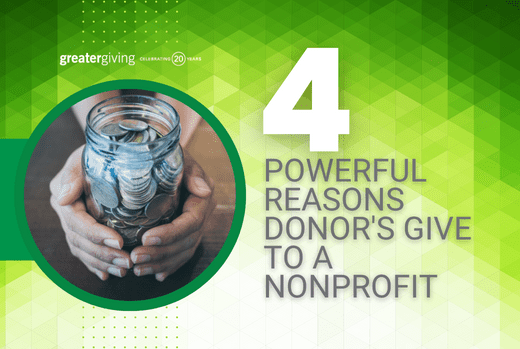
There’s a science to why donors give.
When you’re trying to raise money for your organization, it can be tempting to focus on how much money you’re asking for. But when donors are deciding whether or not to give, they’re not just thinking about the amount—they’re also considering WHY they should give in the first place.
Your donor’s decision to give is composed of three elements: beliefs, emotions, and habits. To effectively appeal to potential donors, you have to understand why they give in order to be successful. There’s a science behind WHY people give, and you can harness it to have more successful fundraising campaigns.
1. Donors Give Because They Have a Personal Connection
Nothing drives a donor to action faster than a personal connection to the mission. Whether it’s direct experience with your nonprofit, or an emotional investment in the work, seeing eye-to-eye with your donor about the fight that needs to be fought—and the method of doing it—is the surest way to securing a gift.
Lean on shared experiences. Determine what brings your donor to the table. What’s drawn them to learning about your nonprofit? What do you and your donor have in common? Use those commonalities to design your ask.
Let’s say your donor tells you, “I have a rescue dog that I love.” Your ask should focus on that experience: “Your gift could bring at least five other wonderful rescue dogs to their forever homes.”
Call on that shared passion for the mission to shape your conversation with your donor.
2. Donors Like to Make a Difference in their community
Community is one of our deepest shared experiences—and you and your donor are both invested in its betterment.
Once you identify the needs within your community with your donor, the two of you can now work together to address those needs. Frame your ask around how your nonprofit will specifically address that need. “With your help, we’ll be able to provide food to a dozen more hungry families in our community.”
Prove your track record to earn their trust. How have you addressed the needs within your community in the past? Show potential donors your successes, and how donated funds have accomplished them.
Seeing what you can do, and that you know how to do it, can inspire donors to give. Have photos, videos, testimonials, and fact sheets available that demonstrate your victories!
3. Donors Want To Be a Part of Something Good
While everyone has the spark of generosity in them, donors are still looking for something in return for their gift: the feeling of doing good. It’s a powerful motivator if you can tap into it. But what makes us feel like we’re doing good? And how will their donation bring them that satisfaction and sense of accomplishment?
Actionable steps and tangible goals are two of the key components. It’s not enough to simply promise that you’ll achieve what you set out to do. You need a definitive benchmark for success, and a strong plan for how to reach it, for your donor to truly feel good about choosing your nonprofit to support.
Follow up with a thank-you. Tell your donor how much their gift means to you and the community you serve, and help them feel that all-important sense of fulfillment.
4. They Were Asked To Become A Donor
It sounds simple, but many fundraisers forget the most important part of the ask: actually asking!
The best conversations with donors are about the mission, the cause, and the work. But that doesn’t always lead to your donor making a gift (even if you’ve spelled out how donations make the work possible!).
Once you and your donor are on the same page about how to achieve the mission, and the role that charitable gifts like theirs play, it’s time to ask them to become a part of the solution. They may not even think of writing you a check until you suggest it!
The truth is, tax deductions aren’t why people generously give to causes they care about.
There are many reasons why people donate to charities, but the ability to claim a tax deduction isn’t usually one of them.
Though tax deductions aren’t the reason that donors give to causes they care about, it is a helpful benefit. There’s a reason that year-end fundraising is so successful: it’s a season of generosity, and a time at which donors are thinking about filing their taxes.
But tax-deductible giving doesn’t only have to happen at the end of the year. Those benefits apply to any donation, at any time of the year! Your nonprofit still needs funding outside of December, and your donor can help make that possible—while receiving the same perks.
Though most donors already know that their gifts are tax-deductible, it’s worth reminding them on your donation page that your nonprofit will send a thank-you letter with the amount of their gift for later use.
The more you know about why donors give, the better your organization will be at making the ask and being successful in that ask.
Donors do not give for any reason other than to support something they care deeply about. What you want to keep in mind when communicating with them is that their intentions are good and pure: your nonprofit needs help, and they want to provide it!
They want to see their money make a difference, and they want to be part of something good. They also give because they want to improve the community and be part of making that happen. And finally, donors give because they trust someone who asks them for money; this could be an organization’s staff member or one of its volunteers, or even a friend who has made a personal connection with the donor in some way. In short, donors give because there is a strong emotional connection between them and your nonprofit’s cause—and that’s what makes asking for donations so powerful!
